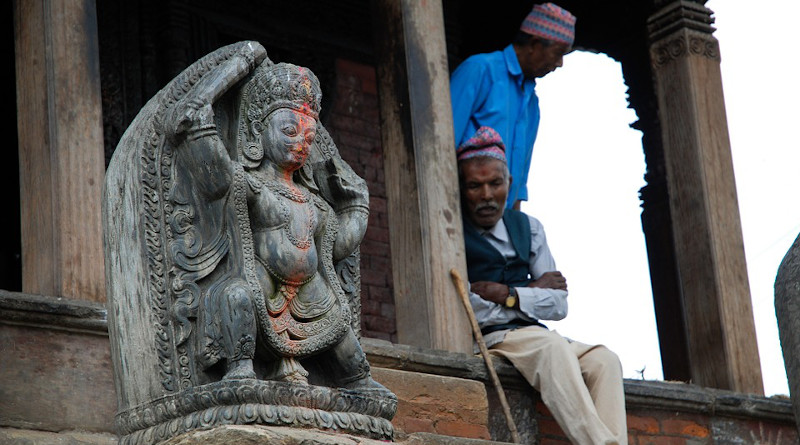Geopolitics Looming Ever Larger In India-Nepal Relations – Analysis
By Amitava Mukherjee
There are quite a few bizarre aspects in the current Indo-Nepal diplomatic flare up. First, and the most important aspect, is the time chosen by Nepal for releasing a new political map claiming some areas long under India’s possession. This happens to be the same time when India is involved in a military stand-off with China over areas in the Ladakh sector. Not content with that, Kathmandu has brought in heavily armed security forces to man quite a number of posts along its border with India. These security personnel recently opened fire on some Indian civilians, killing one of them.
The second unusual scenario is presented by M.K. Naravane, the commander in chief of the Indian army. When Nepal first raised protests over some areas held by India near the international border, Naravane, and not anyone from the civil side of the Indian government, gave his reaction by saying that Nepal had done this “at the behest” of someone else. Again, after Nepal went through all the constitutional requirements and finally released the country’s new political map, it was Naravane who let the whole world know about India’s standpoint: “We have a very strong relationship with Nepal… We have very strong people-to-people connections. Our relations with them (the people of Nepal) have always been strong and will remain strong in the future.”
Now this is an extra ordinary statement coming as it did from an army general. It indicates that in the future, the government of India may ignore Nepal’s political leadership and will, instead, develop close ties with the people of that country. But how can this be achieved if not done through official channels? There are other ways, no doubt. But then the government in Kathmandu will surely attempt to stand in the way. This will give rise to more instability in South Asia.
Undoubtedly the central figure in this convoluted scenario is Kharga Prasad Sharma Oli, the prime minister of Nepal. He is trying to kill several birds with one stone and bears a grudge against India. At one point of time he was known to be a supporter of India. But the equation changed completely when, on an earlier occasion, subtle allegations came to the fore in regard to Indian involvement behind the Maoist leader Prachanda’s decision to pull the rug from beneath Oli’s feet and bring down the government, which the latter led. Later on, however, the parties of Oli and Prachanda merged and formed the Nepal Communist Party (NCP).
In reaching any balanced judgement it may not be proper to conclude that Nepal, particularly its prime minister, is acting at the behest of China, but it is undeniable that a massive chasm has appeared in the Indo-Nepal relationship, and this has sucked Kathmandu deep inside of it, from which the Himalayan republic will find it very difficult to extricate itself. Right now it will be pointless to argue who has shunned whose overtures for talks. Nepal has officially blamed India for the latter’s disinterest in starting negotiations over border disputes. New Delhi has yet to react officially but some Indian news channels, ostensibly egged on by governmental authorities, have brought exactly the same charge against the Nepal government.
Fallout could occur on multiple levels. The first concerns Indo-Nepal bilateral trade, which amounts to more than 57 thousand crores of rupees per year. Nearly 75 percent of Nepal’s imports come from India. It is certain that from India’s end, there will be no attempt to whittle down this quantum. But what will Nepal do? It may not be possible for the Oli government to stick to this amount of trade after the publication of the new political map.
Secondly there is a possibility that the K.P. Oli faction of the Nepal Communist Party will try to whip up ‘nationalist’ sentiment, which is frequently a euphemism for ani-India tirades. This is because Oli is still involved in a running battle for supremacy within the NCP. He is also under pressure for mishandling relief and rescue operations after recent cyclonic storms. A call to “nationalist” feelings may be a handy weapon for Oli.
The third possibility is serious adjustments of the strategic balance in South Asia. This depends on the answer to the question: How deep has China dug its heels in Nepal? Experts point to the rumored Chinese plan to establish a railway link between Kathmandu and Shigatse in Tibet, which will ultimately be extended to Lhasa. For the moment we can set our eyes on the infrastructural projects which already link Nepal with China. The first is the Araniko highway, connecting Kathmandu to the Chinese border at Kodari. The second is the Syaphrubesi (Nepal)- Kyirong(Tibet) road, which was originally a dirt track but has lately been modernized with a 20-million-dollar Chinese investment. This road is directly connected to China’s highway number 318, which leads up to Shanghai.
In the ongoing warlike situation between India and China, Nepal’s sudden claim over certain India-held areas in their new map is bound to raise eyebrows. How Nepal would balance itself in the future South Asian strategic chessboard is an increasingly interesting question.
The views expressed in this article belong to the author alone and do not necessarily reflect those of Geopoliticalmonitor.com or any institutions with which the author is associated.

